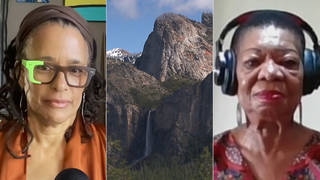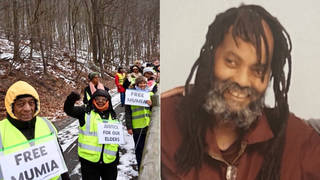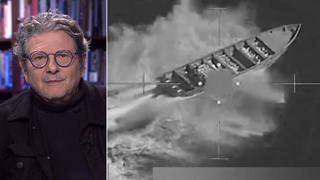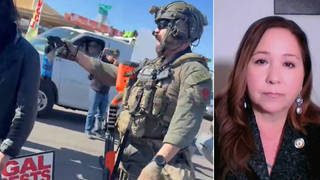
U.S. Border Patrol agents have killed 97 people since 2003, including at least six Mexicans on Mexican soil. Democracy Now! traveled to the borderlands of Arizona earlier this month to cover one of these killings: the death of José Antonio Elena Rodríguez, who was gunned down by a Border Patrol agent in 2012. We met with Richard Boren of the Border Patrol Victims Network in Nogales, Arizona, at exactly the spot where agent Lonnie Swartz pointed his gun through the border wall to shoot and kill José Antonio. At this site, Richard Boren displayed a banner with images of José Antonio and other victims of Border Patrol and told us their stories.
More from this Interview
- Part 1: Justice for José Antonio: Family Demands Accountability for Mexican Teen Killed by U.S. Border Agent
- Part 2: Family of Mexican Teenager Slain by Border Agent Awaits SCOTUS Ruling to Determine If They Can Sue
- Part 3: Border Patrol Has Killed At Least 97 People Since 2003. Hear Some of Their Victims’ Stories
Transcript
AMY GOODMAN: When Democracy Now! was in the borderlands of Arizona in the last few weeks covering the death of José Antonio Elena Rodríguez, we also met with Richard Boren of the Border Patrol Victims Network. He stood in Nogales, Arizona, on the U.S. side of the border wall, at exactly the spot where Lonnie Swartz, the border agent, pointed his gun through the slats in the wall and shot and killed José Antonio October 10, 2012, bullet after bullet after bullet, even as he was down. At this site, Richard Boren displayed a banner with images of José Antonio and other victims of Border Patrol, whose agents have killed at least 97 people since 2003. At least six Mexicans have been killed by Border Patrol on Mexican soil. We want to end today’s show with Richard Boren reading the names of some of the people killed by Border Patrol, and telling their stories.
RICHARD BOREN: Juan Patricio Peraza Quijada, 19 years old, was a guest at the time at Annunciation House in El Paso, Texas. I think it was in 2007. And he was actually killed by the Border Patrol outside the shelter on the street. You know, again, they made up a story saying he was trying to attack agents with a pipe. I mean, it’s just commonplace that witnesses also said that that wasn’t the case at all.
Here is Pablo Santillan, 30 years old, who was another one of the victims on the Mexico side. He was shot by Border Patrol down there Matamoros.
Moving over here, Guillermo Arévalo Pedroza. I think he was about 35 years old. And he was killed. He was at a picnic on the Mexico side, in Nuevo Laredo, enjoying his daughter’s birthday party, when the Border Patrol was on a boat, and they began just shooting wildly on the river. And he was killed and died in his 9-year-old daughter’s arms, in 2010 [sic], I believe.
Valeria Munique Tachiquin, in her thirties, was a mother of five. She was killed by an undercover Border Patrol agent in suburban San Diego. The Border Patrol used to have, and still probably do, a tactic of getting in front of a moving vehicle to justify firing into the vehicle, killing the driver. And so, that’s what happened that day. It was an undercover Border Patrol agent in plainclothes. She may have thought she was being carjacked or something, you know, by this guy. And anyway, he shot and killed her.
And then, Sergio Adrián Hernández Güereca, 15 years old, also one of the victims killed on the Mexico side of the fence, in 2010. And he was killed by a Border Patrol agent who shot him in the head. There’s video of — it looked like he was playing a game of — and some other youth, were playing a game of cat and mouse, just trying to — with Border Patrol, running back and forth and completely unarmed. All of these people were unarmed. And the Border Patrol shot him in the head. The Border Patrol agent in his killing was down on the other side of the fence on the river. He was still on the U.S. side of the Rio Grande. And Sergio was standing on the Mexico side of the river.
Esequiel Hernández, we also added here, because he was killed by the U.S. Marines in 1997 in Redford, Texas. And it just sort of — have the stage for so many other killings, that the Marines were deployed down there at this time to Redford in violation of the Posse Comitatus Act, where they’re not supposed to do any sort of policing in the U.S. It’s commonly violated now. But they were camped outside his home, heavily camouflaged, when he was herding his goats. And he carried a .22 rifle with him to hunt rabbits and so forth, because he — when he would herd his goats. And they shot him in cold blood, as well. And the grand jury refused to indict him. The agent — I’m sorry, the marine was not indicted, and there was no justice for the family, either.
The last one I would like to mention here real quick is Anastasio Hernández Rojas, who was beaten in San Ysidro, California, by about 15 Border Patrol agents when they were trying to deport him. He was handcuffed, laying on the ground. This was photographed and videotaped by bystanders from the bridge overhead, showing him being ruthlessly beaten, crying for mercy. He died, like, the next day from his injuries, being beaten by these Border Patrol agents. And none of them have been indicted and no charges. And that’s, unfortunately, the common theme in all of this, is that the Border Patrol can get away with murder.
I do want to mention somebody who is not on this banner that was killed last year, because these killings still are occurring, and that is Claudia Patricia Gómez González, a Guatemalan indigenous woman who was killed after she crossed the border in Laredo, Texas, and gunned down by Border Patrol and murdered. And the Border Patrol also, as usual, came up with a fabricated story, claimed that she had — with others, had attacked the Border Patrol with two-by-fours. And they actually retracted that story, you know, that that wasn’t true. That’s one of the few times they’ve ever retracted a story. But yet there’s been no charges filed against those agents, either, against, you know, the death of this young woman.
AMY GOODMAN: That’s Richard Boren with the Border Patrol Victims Network. One of the victims Richard named, Guillermo Arévalo Pedroza, was actually killed in 2012, not 2010. Richard was standing at the site on the U.S. side of the border, up against the border wall, up against the slats, where he had put his mural, right where Lonnie Swartz took his gun, the border agent, and shot through the slats and killed José Antonio Elena Rodríguez.
Special thanks to our team on the ground in Arizona: Tey-Marie Astudillo, Charina Nadura, Maria Taracena, John Hamilton, Libby Rainey and Denis Moynihan.
That does it for our broadcast. Democracy Now! is produced by Mike Burke, Deena Guzder, Nermeen Shaikh, Carla Wills, Tami Woronoff, Sam Alcoff, Robby Karran, Hany Massoud. I’m Amy Goodman. This is Democracy Now! Go to our website for our full series, “Death and Resistance on the U.S.-Mexico Border.” Thanks so much for joining us.












Media Options